September 28, 2011The sky sulks, there’s a light drizzle, and a long, lazy swell is rolling around from nowhere in particular. It’s a melancholy day, our second-to-last, and the mood is either enhanced by or reflected in the weather; I’m not sure which. I’m sorry to see this cruise end. I’m not alone in that, though the crew, some of whom have been aboard for four months, don’t universally share the feeling. Nine crew are getting off tomorrow in Isafjördur. Their life aboard—and their view of endings—tends to be different from that of the science parties who come and go. Still, objectively speaking, this cruise has been special. There’s no competing with that 2008 cruise in these same waters and with many of the same people, for spectacular weather. But for variety and for the level of scientific success, this one is unbeatable.
Lena Schulze cuts the CTD wire symbolizing the end of the CTD line. © Rachel Fletcher We stopped twice in different north-Iceland fjords, one stop planned, the other not so much. We came close aboard the unforgettable Blosseville Coast of East Greenland and later the Faroe Islands. In both places we deployed small boats in the service of photography. None of Knorr’s old guard remembers so many small-boat deployments, and some said they dreaded the near approach to land for fear that the outreach group would want to do it again. During the first part of the cruise, we deployed eight moorings in the Denmark Strait where they will remain for a full year collecting temperature, salinity, and velocity data about this vital arc in the North Atlantic’s Meridional Overturning Circulation. When we return next August to turnaround the moorings and retrieve their data, we’ll be a giant step closer to understanding the ways and means of the ocean in this vicinity. It is not to diminish its importance or the skill required to execute it to say that mooring work is typical to most physical oceanography expeditions. The second part of the cruise was far from typical.
The Pilot boat in Isafjordur. © Rachel Fletcher Most expeditions end without clear conclusions, because their function is to collect, not to parse and interpret, the data. That comes later, and often takes a year or more for the scientist(s) to do both. But this time the science was downright literary. It had structure—a clear objective, a search, and a climatic conclusion. And it obeyed the unity of time; when the cruise was complete, so was the story. Even now I can hear Bob saying, quite fairly, that he doesn’t want to give the impression that the work is done. It’s far from done. Bob and Kjetil are awash in data yet to be understood. And their discoveries have presented a new set of questions about just what is going on out here in the Nordic Seas. But let’s call that the denouement. The cruise story is still complete. It’s the story of the march of science in miniature.
A rainbow welcomes videographer Ben Harden and photographer Rachel Fletcher into the town of Isafjordur. © Rachel Fletcher The Icelanders, with far too few instruments, happened to catch a snapshot signal of something moving where such movement was never noticed before, and they were shrewd enough to take it for what it turned out to be, a hitherto unknown current. But without Bob, no one could have said anything more definitive than maybe it exists, maybe not. With careful, high-resolution measurements and this ship from which to make them, Bob verified in 2008 the existence of the North Icelandic Jet and its contribution of half of the water passing through the Denmark Strait Overflow. But where did this North Icelandic Jet come from? Or if it didn’t come from anywhere, how did it come to exist? Bob and Kjetil formulated that hypothesis: The NIJ doesn’t flow from somewhere to somewhere else like most ocean currents. No, it’s produced right here on the north and northeast coasts of Iceland by a complex oceanographic process we can sum up by paraphrasing Newton’s Second Law: If water goes north, then an equal quantity must go south. It happens on a hemispheric scale in the MOC—on a miniature scale here in the NIJ. However, Bob says he could not have come up with the hypothesis without the theoretical work by his colleague the modeler Michael Spall. His work supplied the clues to form the hypothesis, but it alone would have proven nothing. Someone still had to come out here in a ship to make the painstaking measurements, while remaining nimble enough to follow the leads wherever they led. That brings us to the present cruise, and presently to its end.
Looking straight up one of the mountains in Isafjordur. © Rachel Fletcher Thirty days after leaving Reykjavik, after covering 3,812 nautical miles, collecting real-time data from 335 CTD casts and reams of velocity data from the ADCPs, after spending twelve and more hours a day in headphone isolation at their computers, Bob and Kjetil found, without question or ambiguity, the origin of the NIJ. It was right here, just as they’d hypothesized, in the waters on the slope of Iceland, and it flowed over the fjord-riven, claw-shaped appendage to which we’re now heading on the northwest side of the island—and into the Denmark Strait. Like all good quest stories, this one ends decisively with, in this version, the object attained. That’s very unusual in at-sea oceanography, maybe in Earth science research more generally.
The town of Isafjordur is a small town with a population of around 3,500. © Rachel Fletcher Like most sea stories, this one ends at some destination. Unlike many, there were no injuries, no loss of life to the heartless ocean (one guy lost a filling), and no privation, well, at least not too much. And now the end is literally in sight, a fjord on that strange northwest coast and the town it shelters. Most of both watches are up and about at 0730. We’re supposed to pick up the harbor pilot in an hour, but the big cruise ship presently occupying his attention could delay that. The Skip’s on the bridge with Jose, the helmsman, Second Mate Jen, and the inevitable spectators. Kyle and the deckies have laid out the mooring lines, tied on the heaving lines, readied the anchor and the gangway. Now Kyle’s in the bosun’s place on the bow with Chief Mate Adam; Mike, the Third Mate, is on the stern. These people who approach things with relaxed, joking informality are now, when it’s necessary, straight-up, serious professionals at work. It’s fun to watch this nautical competence, but sad, too. I’m leaving the ship in Isafjördur, and I don’t know when I’ll be back. The Skip, at the controls, and his crew put her starboard side-on to the industrial wharf lined with metal-sided warehouses (“These are the same harbor-side buildings I see wherever I go,” Kevin said, “I think they just move them from place to place.”) The heaving lines arced onto the concrete wharf; the heavy hawsers followed; the pilot left the ship; the gangway was craned into place and made fast. That’s as over as a cruise gets.
Still, I’m standing around on the side deck talking with the regulars and some of their regular replacements I’ve sailed with before to prolong the leaving. Most of the science staff have already left for the airport. The mates and the engineers are going through the changeover procedures, and I’m drinking another cup of coffee. I don’t want this sea story to close; but all must. Knorr’s people have treated me like one of their own, and that’s a privilege I’ll never forget. And after copping in one of the first essays to the tendency toward sentimentality about the ocean and ships, particularly Knorr, I promised to repress it. The thought of not seeing her or them again is too sad to brook without breaking the promise. Bon voyage to Knorr and all who sail in her. Last updated: December 27, 2011 | |||||||||||
Copyright ©2007 Woods Hole Oceanographic Institution, All Rights Reserved, Privacy Policy. | |||||||||||


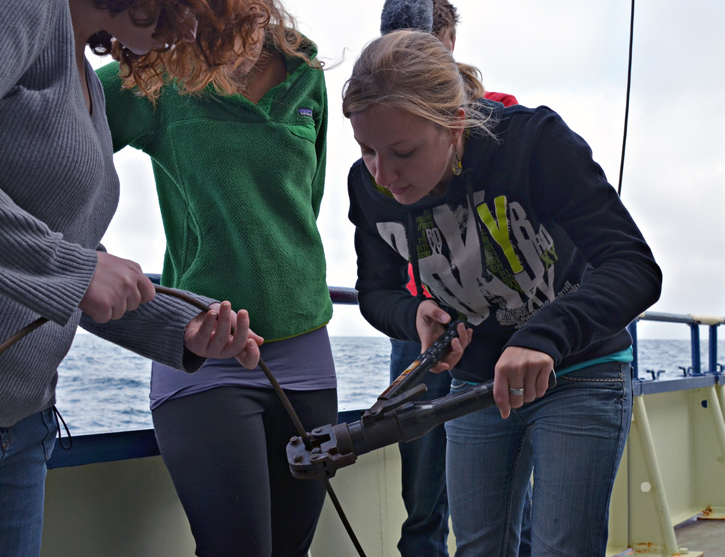
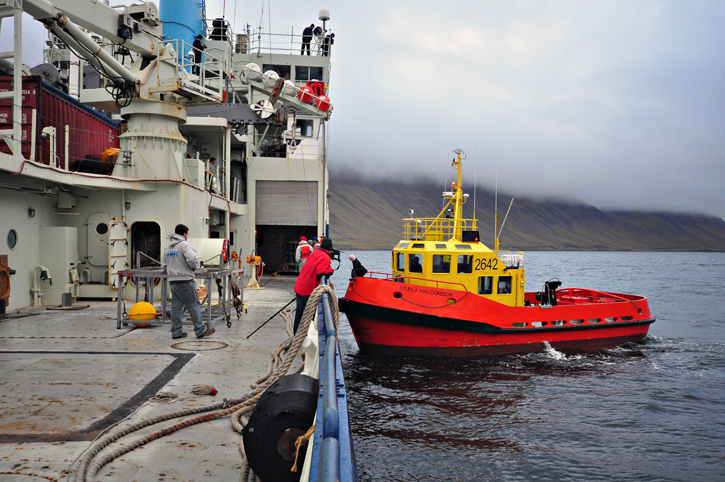
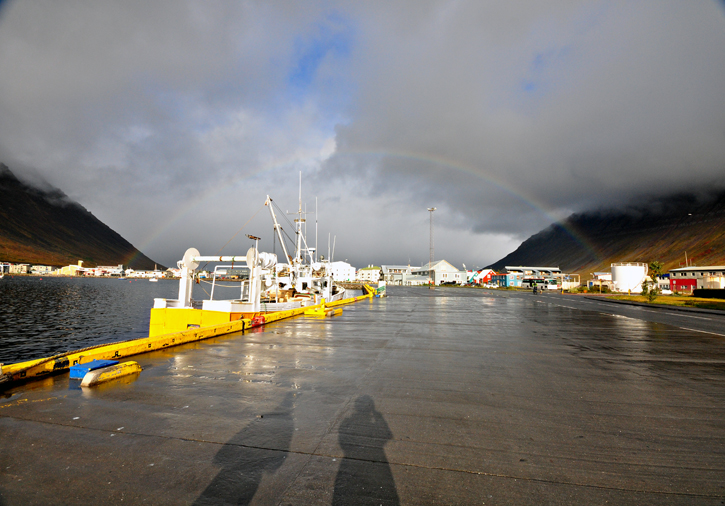
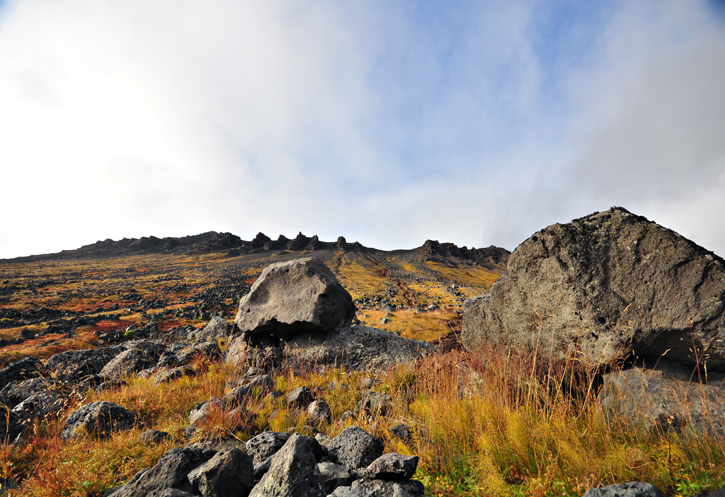
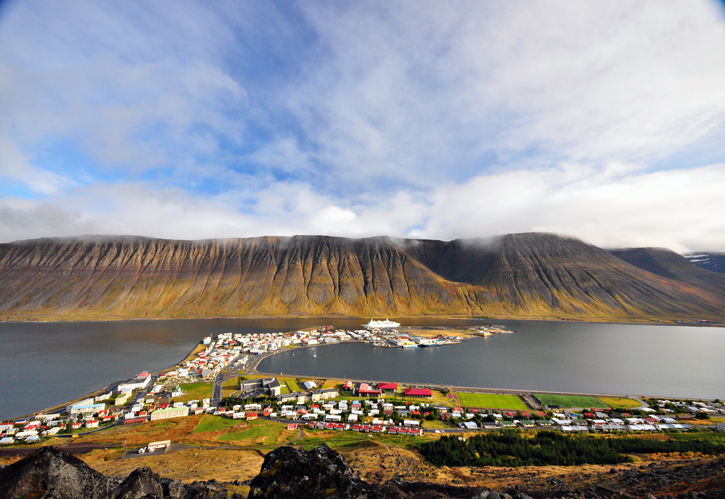
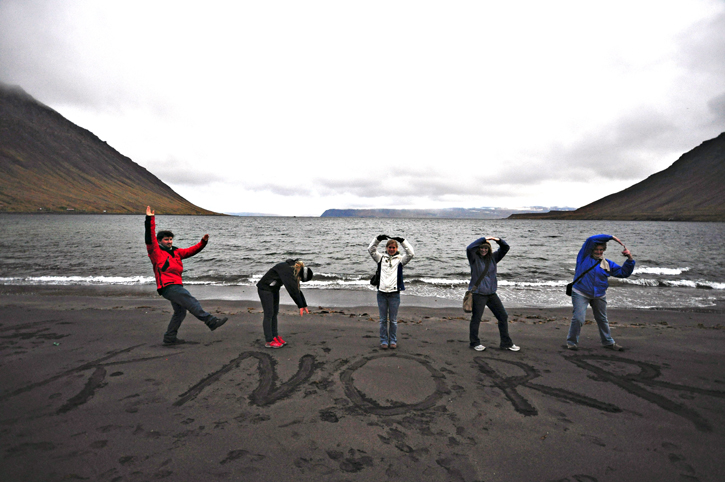 Ben Harden, Stine Hermansen, Stefanie Zamorski, Ashley Stinson and Pat Keoughan spell out the Knorr in Isafjordur. © Rachel Fletcher
Ben Harden, Stine Hermansen, Stefanie Zamorski, Ashley Stinson and Pat Keoughan spell out the Knorr in Isafjordur. © Rachel Fletcher 